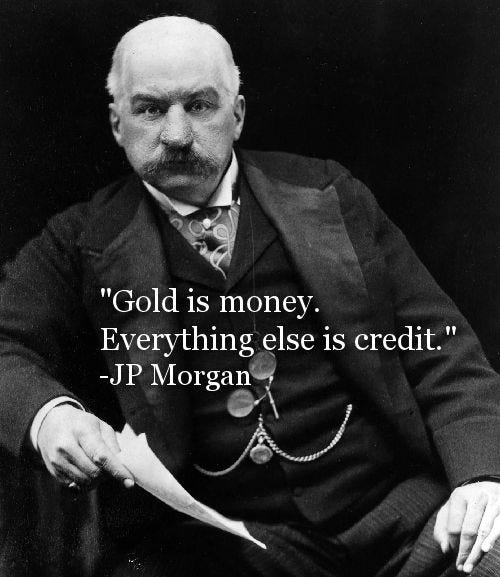Good As Gold
The truth behind gold’s rise and how high its price will go
J. Pierpont Morgan, probably the greatest financial mind America has ever produced, famously said, “Gold is money. Everything else is credit.” How right he was.
During the Civil War, the American money supply began a fateful transition away from gold and towards debt backing. That culminated with Nixon’s catastrophic decision to end the dollar-gold exchange standard, something we’ve detailed in a previous post.
Today, the Federal Reserve Notes we call money aren’t even backed by debt—they are debt.
And, like all debt, it’s not a sure thing. Its value goes up and down depending on the likelihood of repayment.
What has become painfully clear over the last four years is that repayment of that debt won’t happen—at least not in the amount you thought you’d get.
Consider that if you kept a dollar in your pocket for the last three and a half years, it lost 20% of its value. Today, it buys just 80% of what it could when you first deposited it into your pocket.
And gold? The “barbaric metal” as Keynes called it has rocketed up 51% since the start of 2020. That raises two questions: What’s behind the rise and where does gold go from here?
Many brush off the rise in the gold price as unrelated to inflation because the two don’t match perfectly. In other words, the decline in the dollar’s purchasing power doesn’t perfectly match the increase in the gold price measured in those dollars.
But that’s only true in the short run. Because of the speculation surrounding gold and a possible return to its use in a monetary system, gold has more volatility than a typical precious metal. But in the long run, the dollar cost of gold is highly informative as to the dollar’s value.
Since the last vestige of the dollar’s link to gold was broken on that terrible Sunday of August 15, 1971, gold has risen 6,000%. Put differently, the dollar has lost 98% of its value.
In reality, the dollar had been losing value for half a century before the gold window closed. The Fed, Treasury, and State Department had been manipulating foreign affairs and rigging international markets to artificially maintain the dollar’s value.
The promise to redeem dollars for gold was an increasingly thin façade to help uphold the ruse.
That means the more accurate comparison is to go all the way back to the Great Depression when FDR confiscated gold and then revalued it at $35 an ounce, and compare the dollar’s purchasing power at that point in time to today.
Sure enough, the dollar has lost 98% of its value since then, as measured by what the typical urban American consumer buys. That’s also precisely the dollar’s devaluation as measured by the cost of gold.
So, while gold behaves like a speculative commodity in the short-run, it’s an inflation hedge in the long-run.
As we mentioned last week, one of our team members took note of this and plowed a quarter of his portfolio into gold at the start of this year. The rationale was simple: gold hadn’t moved much from its highs in late-summer 2020, but the dollar had lost 20% since then.
Gold was due to launch higher. And it did—by 15%.
The answer to the first question (what’s behind the recent rise in gold?) is simple: the inescapable inflation-hedge nature of the barbaric metal is catching up to the market. As dollars loses value over time, it takes more of them to buy the same amount of gold.
That brings us to the second question: where does gold go from here? Forecasts from Wall Street firms vary widely on this one, so here’s where we turn it over to one of our in-house economists who has been right on gold thus far.
Keep reading with a 7-day free trial
Subscribe to FX Hedge Newsletter to keep reading this post and get 7 days of free access to the full post archives.







